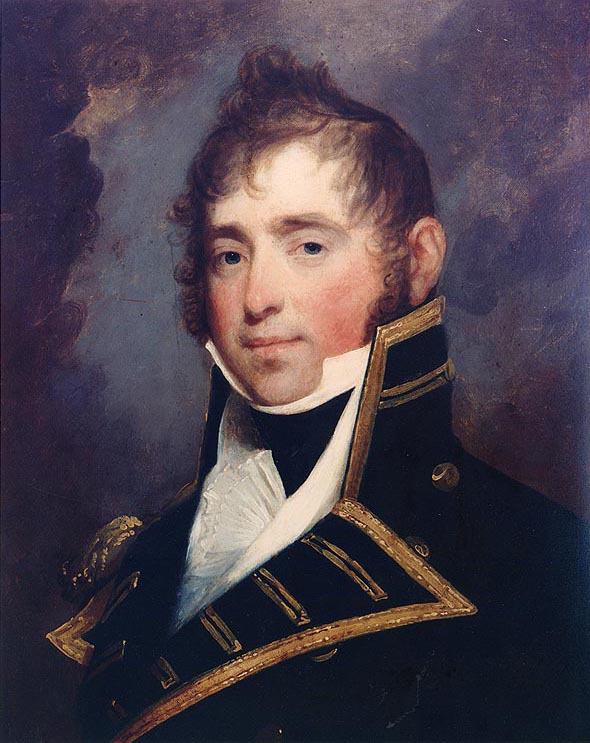Don't Give Up the Ship!
These were the dying words of Lawrenceville's namesake Captain James Lawrence spoken 200 years ago on June 1, 1813.
 James Lawrence was born in Burlington, New Jersey, on October 1, 17811. He was the son of John Lawrence, a respected lawyer, and Martha Tallman. His mother died when he was an infant and he was raised by his half-sister Elizabeth2. Though he studied law, he joined the United States Navy in September 1798 as a midshipman and served in the ship Ganges and frigate Adams during the undeclared war with France. Commissioned a Lieutenant in 1802, he served in the schooner Enterprise during the War with Tripoli. In February 1804, he was second in command during the expedition to destroy the captured frigate Philadelphia. Later in the war he commanded Enterprise in battles with the Tripolitans. He was also First Lieutenant of the frigate John Adams and, in 1805, commanded the small Gunboat Number 6 during a voyage across the Atlantic to Italy. Lieutenant Lawrence then commanded the warships Vixen, Wasp, and Argus. Promoted to the rank of Master Commandant in November 1810, he took command of the sloop of war USS Hornet a year later and sailed her to Europe on a diplomatic mission. From the beginning of the War of 1812, Lawrence and Hornet cruised actively, capturing the privateer Dolphin in July 1812, blockading the British sloop HMS Bonne Citoyenne at Bahia, Brazil at the end of the year, and on February 24, 1813 captured HMS Peacock.
James Lawrence was born in Burlington, New Jersey, on October 1, 17811. He was the son of John Lawrence, a respected lawyer, and Martha Tallman. His mother died when he was an infant and he was raised by his half-sister Elizabeth2. Though he studied law, he joined the United States Navy in September 1798 as a midshipman and served in the ship Ganges and frigate Adams during the undeclared war with France. Commissioned a Lieutenant in 1802, he served in the schooner Enterprise during the War with Tripoli. In February 1804, he was second in command during the expedition to destroy the captured frigate Philadelphia. Later in the war he commanded Enterprise in battles with the Tripolitans. He was also First Lieutenant of the frigate John Adams and, in 1805, commanded the small Gunboat Number 6 during a voyage across the Atlantic to Italy. Lieutenant Lawrence then commanded the warships Vixen, Wasp, and Argus. Promoted to the rank of Master Commandant in November 1810, he took command of the sloop of war USS Hornet a year later and sailed her to Europe on a diplomatic mission. From the beginning of the War of 1812, Lawrence and Hornet cruised actively, capturing the privateer Dolphin in July 1812, blockading the British sloop HMS Bonne Citoyenne at Bahia, Brazil at the end of the year, and on February 24, 1813 captured HMS Peacock.
Lawrence returned to the United States in March, having been promoted to Captain in January, and two months later took command of the frigate Chesapeake, then preparing for sea at Boston. She left port on June 1, 1813 and immediately engaged the Royal Navy frigate Shannon in a fierce battle 20 miles outside of Boston. Although of comparable sizes, Shannon had a well-drilled crew whereas almost half of Chesapeake's crew was new to the ship and Shannon disabled Chesapeake with gunfire within the first few minutes. Captain Lawrence, mortally wounded by small arms fire, ordered "Don't give up the ship" as he was carried below however his crew was overwhelmed by British boarders shortly thereafter. Captain Lawrence died of his wounds on June 4 while her captors were sailing Chesapeake to Halifax, Nova Scotia. He was buried with military honors at Halifax but later reinterred at Trinity Church Cemetery in New York City
When Lawrence's friend and fellow officer Oliver Hazard Perry heard the news of his death he ordered a large blue battle ensign be made stitched with the phrase "Don't Give Up The Ship" in bold white letters. This flag was displayed on his flagship during his victorious engagement against the British at the Battle of Lake Erie three months later.
Besides being honored with a Congressional Gold Medal and the Thanks of Congress, there are 10 counties, five cities or towns, and at least one school named for him. Additonally the U.S. Navy has named five ships USS Lawrence. He was survived by his wife, Julia Montaudevert Lawrence, and two-year-old daughter Mary Neill Lawrence. A posthumous son, James Montaudevert died in infancy.
1 Author James Fenimore Cooper was born in the house next door in 1789.
2 Contrary to some reports, his father never fled to Canada but was a loyalist who tried to stay neutral during the war and served conscientiously in the local and state government. He moved to Canada in 1795, a year before he died.



